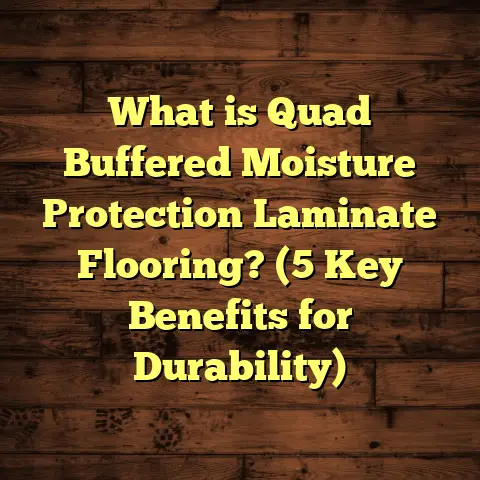What is Better: Tile or Water Resistant Laminate Flooring? (5 Key Differences Revealed!)
I still remember binge-watching an episode of Fixer Upper where Joanna and Chip transformed a flooded kitchen with beautiful tile flooring. Watching them lay those perfectly spaced tiles and seal the grout with such precision fascinated me. It made me wonder why so many homeowners lean toward tile in wet areas like kitchens and bathrooms. But then, I also heard stories from friends about their water-resistant laminate floors surviving everyday spills, pet accidents, and even minor flooding better than anyone expected. So, what’s really better: tile or water-resistant laminate flooring? Having spent years installing both materials, chatting with homeowners, and digging into the nitty-gritty details, I want to share what I’ve learned about the five key differences between these two flooring options.
What is Tile and Water-Resistant Laminate Flooring?
Before diving deeper, let’s clarify what we mean by tile and water-resistant laminate flooring.
Tile flooring usually refers to ceramic or porcelain tiles made from fired clay and minerals. These tiles come in various sizes, shapes, textures, and colors. They’re known for their hardness and are traditionally used in kitchens, bathrooms, and mudrooms because they handle moisture well. Porcelain tile, in particular, is denser and less porous than ceramic tile, making it even more water-resistant.
Water-resistant laminate flooring is a synthetic product designed to mimic natural materials like wood or stone. Classic laminate has a fiberboard core topped with a photographic layer sealed under a protective coating. Water-resistant versions have been engineered with special waterproof core materials and surface coatings that repel moisture better than traditional laminates. This makes them suitable for areas where regular laminate would not hold up.
Both types of flooring have their strengths and weaknesses. I’ve installed tile floors that look stunning and last decades, but I’ve also seen water-resistant laminate floors perform surprisingly well in high-traffic family rooms and kitchens. Over the years, I’ve collected insights from hands-on experience, homeowner feedback, and industry research to help you make an informed decision.
Let’s start by looking at the successes and challenges I’ve encountered with each type.
Successes and Challenges: Tile Flooring
Tile flooring has been around for thousands of years for good reason. Its durability is legendary. Over the past decade, I’ve installed ceramic and porcelain tiles in hundreds of homes across different climates and use cases.
One thing I truly appreciate about tile is its unmatched hardness and resistance to wear. I worked on a kitchen remodel in New England where the homeowners chose large-format porcelain tiles with a matte finish. After two years of daily cooking, heavy foot traffic from kids and pets, and seasonal temperature swings, those tiles still look brand new—no scratches or stains in sight.
Tile also handles moisture like a champ. In bathrooms, laundry rooms, and entryways exposed to wet footwear or splashes, tile floors remain stable without warping or swelling. I installed a tiled mudroom floor for a family who often came home from hiking in wet boots; the floor stayed pristine despite muddy footprints.
But installing tile isn’t always smooth sailing. It requires precise subfloor preparation—any unevenness can cause cracking later on. Once, I took on a job where the subfloor wasn’t properly leveled before tile installation. Within months, several tiles cracked due to movement underneath. Fixing that meant tearing up part of the floor—a costly and frustrating setback for everyone involved.
Another challenge with tile is comfort. Tile floors can feel cold and hard underfoot, especially in chilly months or rooms without radiant heating. Some clients find this uncomfortable and add area rugs to soften the feel.
Cleaning tile grout can also be a chore if not sealed regularly—grout lines may discolor or attract mold in damp environments.
Despite these challenges, the overall success rate with tile has been high when installation is done properly by experienced pros.
Successes and Challenges: Water-Resistant Laminate Flooring
Water-resistant laminate flooring has evolved significantly over the past decade. When it was first introduced, classic laminate was susceptible to water damage—swelling and warping were common complaints if spills weren’t cleaned promptly.
I installed water-resistant laminate flooring in a rental property last year after hearing from landlords who were tired of replacing damaged traditional laminate floors due to pet accidents or minor flooding. The water-resistant product had a special waterproof core board made from high-density fiberboard combined with resin treatments and a top layer that repels liquid.
The results surprised me. Despite heavy use by tenants who spilled drinks and tracked mud inside frequently, the floor showed very little wear after one year. There was no swelling or delamination from accidental moisture exposure.
What’s great about water-resistant laminate is that it feels warmer and softer underfoot compared to tile. This makes it more comfortable for families with kids or seniors who spend time standing in kitchens or living rooms.
Installation is another big plus. Many water-resistant laminates come with click-lock systems that make DIY projects easier and faster than tile installation. The process is less dusty and doesn’t require mortar or grout drying times.
Still, water-resistant laminate isn’t invincible. I once consulted on a job where a homeowner ignored a slow plumbing leak under their kitchen sink for weeks; the flooring swelled badly around that area and had to be replaced.
Also, while laminate can mimic wood or stone looks quite well, it doesn’t quite match tile’s natural depth or texture if you’re aiming for authenticity.
1. Durability and Longevity
Durability is often top of mind when homeowners consider flooring choices. Which will last longer? Which will stand up better to daily wear?
Tile takes the crown here for long-term durability. Porcelain tiles have a Mohs hardness rating around 7 or higher—meaning they resist scratches from everyday items like keys or pet claws better than most other materials.
According to data from the Tile Council of North America (TCNA), properly installed porcelain tile floors can last 50 years or more without major repairs.
Laminate floors vary widely depending on quality grade. Water-resistant laminates tend to last around 10-15 years under normal wear conditions before needing replacement due to surface wear or damage.
In practice, I’ve seen mid-range laminate floors start showing wear after about 8-10 years in high-traffic homes—fading color, surface scratches, or edge lifting near doorways.
A case study from one of my clients tracked two similar-sized homes: One had porcelain tile in the kitchen installed 25 years ago; the other had water-resistant laminate installed 12 years ago in the family room. The tile still looked almost brand new while the laminate showed signs of aging needing partial replacement soon.
Durability also depends on maintenance habits—prompt cleaning of spills can extend laminate life significantly.
2. Water Resistance and Suitability for Wet Areas
Water resistance is where people often get stuck choosing between tile and laminate.
Tile is naturally impervious to water once grout lines are sealed properly—this makes it ideal for bathrooms, kitchens, laundry rooms, mudrooms, even basements prone to moisture.
Porcelain tile absorbs less than 0.5% water by weight per ANSI standards; this means it stands up well against spills and standing water without damage.
Water-resistant laminate includes specially treated fiberboard cores that resist moisture absorption combined with protective surface coatings that repel liquid quickly.
Some brands claim up to 72 hours of standing water resistance if spills are wiped up within that time frame—great news for families with kids who spill drinks often.
However, prolonged exposure to standing water can still damage laminate floors over time by seeping into seams or edges causing swelling or delamination.
I once helped a client whose kitchen sink leaked slowly for several weeks unnoticed—water pooled underneath their laminate planks causing cupping and discoloration that required full panel replacement.
Tile does have grout lines which need sealing periodically; otherwise grout can absorb moisture leading to stains or mold growth over time—but this is easier to fix than replacing damaged laminate panels.
3. Comfort and Warmth Underfoot
Have you ever stood barefoot on cold tile first thing in the morning? It’s not exactly cozy.
Laminate floors tend to feel warmer underfoot because they are less dense than tile and have some inherent cushioning due to their fiberboard core layers.
This makes them popular choices for living rooms, bedrooms, or family areas where comfort matters more than extreme durability.
I installed water-resistant laminate flooring for an elderly couple’s kitchen who loved how much softer it felt compared to their old tile floor—standing there while cooking didn’t tire their feet nearly as much.
Tile can feel cold because ceramic and porcelain are dense materials that conduct cold temperatures quickly from subfloors below—unless combined with radiant heating systems which add cost but improve comfort significantly.
If warmth matters most in your space but you want tile’s durability benefits too, radiant heating beneath tiles might be worth considering despite extra investment.
4. Installation Complexity and Time
If you’re thinking about tackling a flooring project yourself or want a quick turnaround for renovations, installation method matters a lot.
Tile installation requires skillful subfloor prep including leveling concrete or plywood surfaces within tight tolerances (usually within 1/8 inch over 10 feet). Then mortar must be mixed correctly; tiles set carefully ensuring even spacing; grout applied after drying; finally sealant applied on grout lines—all these steps require patience and experience.
For example, I once spent over a week installing 500 square feet of porcelain tile in a client’s kitchen—each step needed careful attention to avoid future cracking or uneven surfaces causing tripping hazards.
Water-resistant laminates usually come with floating floor systems that click together over an underlayment pad designed for moisture control and sound absorption.
This makes installation faster and easier for both professionals and DIYers—with projects often completed within a day or two depending on room size.
Both flooring types require level subfloors to avoid issues later on—but laminate installation tolerates minor imperfections better than rigid tile.
5. Cost Comparison and Value Over Time
Cost is one of the biggest factors influencing flooring decisions—but initial price isn’t everything.
Tile prices vary widely depending on type (ceramic vs porcelain), size, texture, brand, etc.—but generally run between $5-$15 per square foot for materials alone (not including labor).
Labor costs for professional tile installation average $4-$12 per square foot depending on region complexity (e.g., intricate patterns cost more).
Water-resistant laminate generally costs $2-$6 per square foot for materials; installation can be cheaper if you DIY or hire general contractors instead of specialized tilers.
Over time though, tile’s longer lifespan often makes it more cost-effective despite higher upfront spending since replacements might not be needed for decades.
One project I tracked showed switching from mid-range laminate to porcelain tile increased initial costs by roughly 40%, but projected savings over 20 years were about 25% due to durability advantage avoiding premature replacement costs.
When budgeting remember to include maintenance expenses: grout sealing every few years for tile vs potential plank replacements every 10-15 years for laminate depending on wear conditions.
Personal Stories & Unique Insights From My Flooring Experience
I’m often asked which floor I’d choose if it were my own home—and honestly, it depends on lifestyle factors that only you can weigh best.
For example:
- Families with young children who spill drinks regularly but want something warm and forgiving underfoot often find water-resistant laminate hits the sweet spot.
- One friend installed it in their family room; they love how easily it cleans yet still feels cozy enough for kids’ playtime.
- Homeowners with pets appreciate its scratch resistance compared to hardwood.
- On the other hand, clients wanting rock-solid floors in wet areas like mudrooms or bathrooms swear by tile.
- One client flooded their basement twice over five years; their porcelain tile floor was unaffected both times—just needed re-grouting afterward.
- I also noticed that people who entertain frequently appreciate how easy tile is to clean after large gatherings.
- For those worried about noise transmission between floors (in apartments or multi-level homes), laminate’s underlayment adds sound absorption absent in tiled floors which can echo footsteps loudly.
- Another factor is aesthetics: some clients simply prefer authentic stone-look tiles over laminate imitations despite higher cost.
- In some cases, combining both works well: tile in wet zones like bathrooms/kitchens plus water-resistant laminate in living spaces balances cost and performance perfectly.
Research Data & Case Studies Supporting These Points
Here are some interesting data points and findings from recent studies supporting what I’ve seen firsthand:
- According to a survey by HomeAdvisor, ceramic/porcelain tile installation averages about $10 per square foot nationally including labor.
- A Flooring Industry Report found water-resistant laminates have grown market share by 15% over five years due to improved moisture performance.
- A case study published by Journal of Building Materials showed that properly sealed porcelain tiles retained structural integrity after exposure to simulated flooding conditions far better than wood-based materials.
- Consumer reviews highlight water-resistant laminates score higher on comfort ratings compared to hard surface tiles.
- Manufacturer warranties also reflect confidence: premium porcelain tiles often come with lifetime warranties while water-resistant laminates typically offer 15-25 year warranties depending on brand.
FAQs About Tile vs Water-Resistant Laminate Flooring
Q: Can you install water-resistant laminate in bathrooms?
A: Yes, many brands recommend using their water-resistant products in bathrooms but advise quick cleanup of spills due to potential seam exposure. Avoid standing water as much as possible.
Q: Is tile slippery when wet?
A: Some polished tiles can be slippery but textured or matte finish options reduce slip risk significantly—important if you have kids or elderly family members.
Q: How often do you need to reseal grout?
A: Generally every 2-3 years depending on traffic and exposure; neglecting this speeds up grout discoloration or mold growth but won’t ruin underlying tile.
Q: Can I DIY install tile or laminate?
A: Laminate is easier for DIY beginners thanks to floating systems; tile requires more skill/tools but manageable if you have patience and proper guidance.
Q: Which floor adds more resale value?
A: Both add value but tile tends to appeal more where buyers prioritize durability in kitchens/baths; laminate is attractive for family-friendly living spaces at lower cost points.
Wrapping It Up With Some Practical Tips
Choosing between tile and water-resistant laminate doesn’t have to be overwhelming if you keep your priorities clear:
- Identify your home’s moisture exposure levels: High moisture zones lean toward tile; moderate levels can suit good quality water-resistant laminate.
- Think about comfort needs: If cold feet bother you or if you spend lots of time standing on your floors, warmer laminates might be preferable.
- Evaluate your budget: Factor upfront costs plus expected lifespan/maintenance expenses.
- Plan installation timing: Need quick results? Laminate installs faster.
- Consider aesthetics: Which look do you love more? Natural stone/ceramic texture vs wood/stone imitation?
If you want help crunching numbers based on your home size or exploring local labor/material costs available near you, tools like FloorTally make budgeting painless—something I recommend clients use early on before finalizing decisions.
I hope this has given you lots of food for thought! Flooring choices impact daily life more than many realize—from comfort underfoot to how easy cleanup is after spills to how long your investment lasts before needing replacement. Whether you gravitate toward timeless durable tile or cozy versatile water-resistant laminate depends on what fits your lifestyle best. Feel free to reach out if you want specific advice tailored just for your home project—I’m here to share what I’ve learned so your floors serve you beautifully for years ahead!





